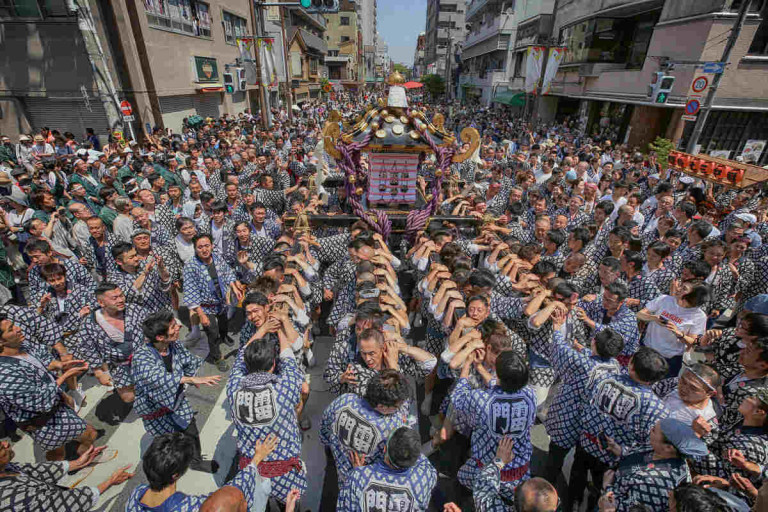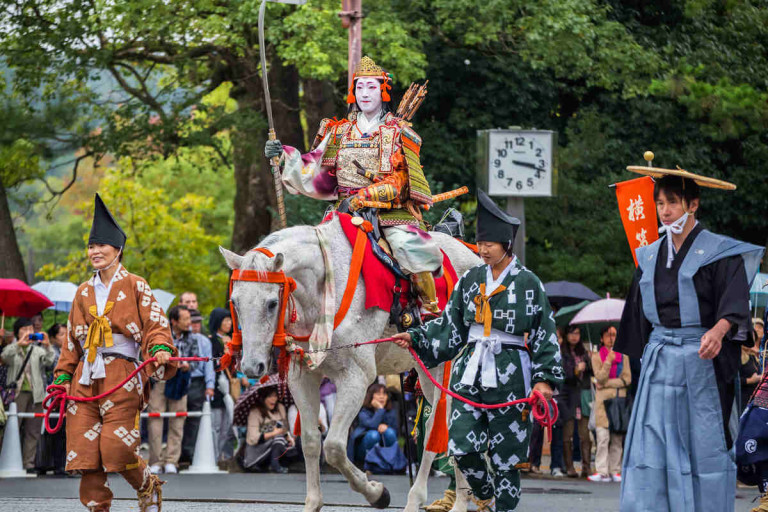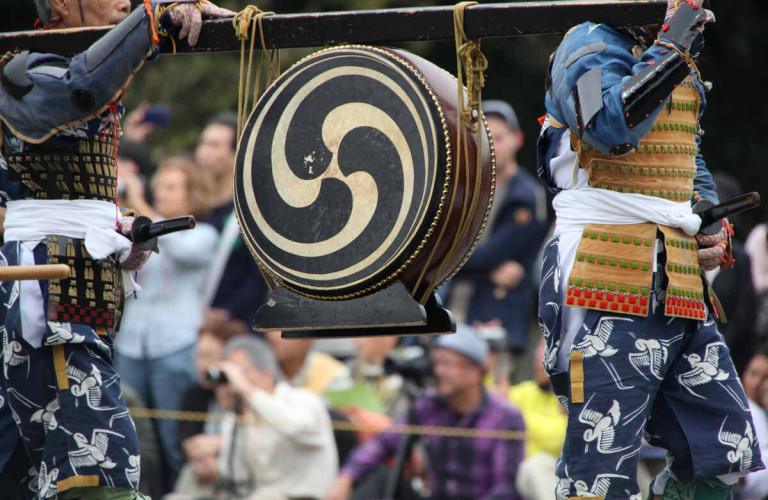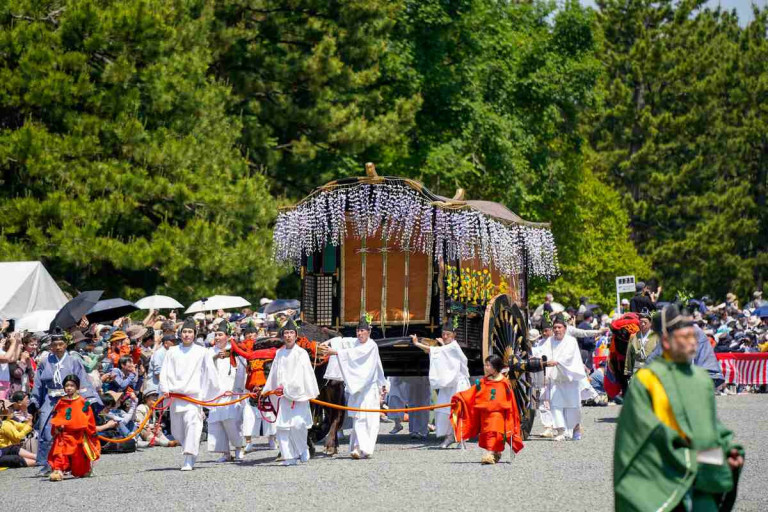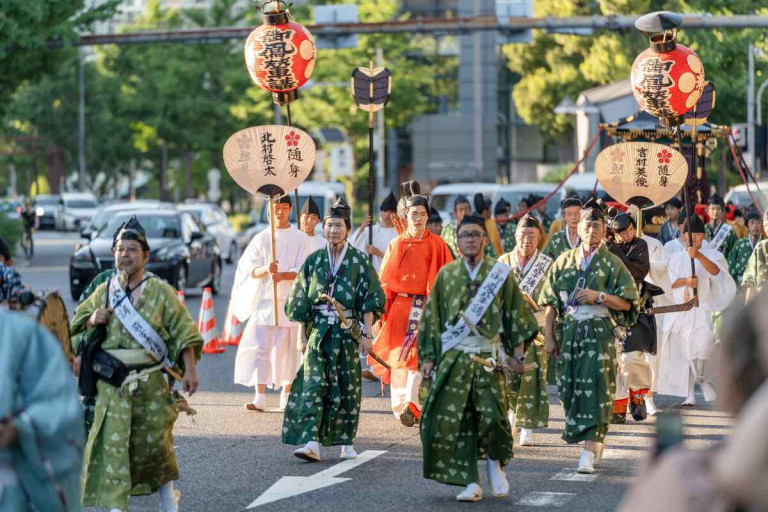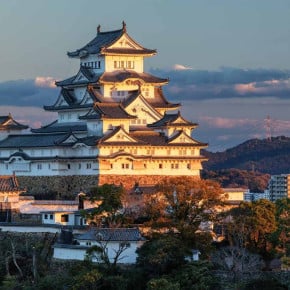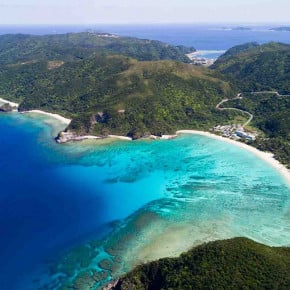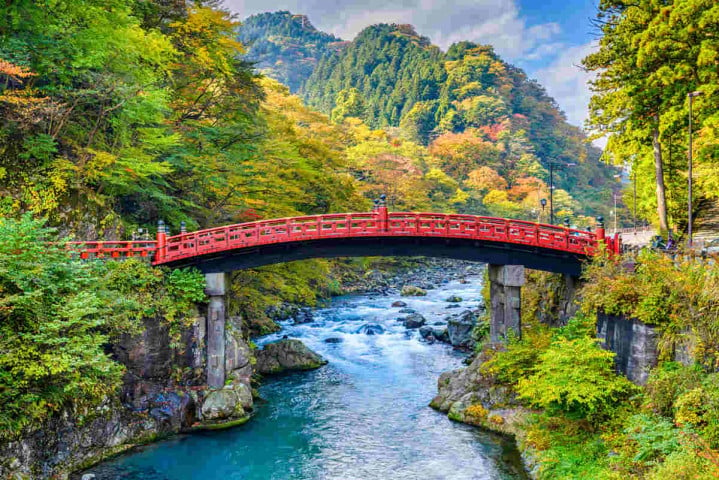
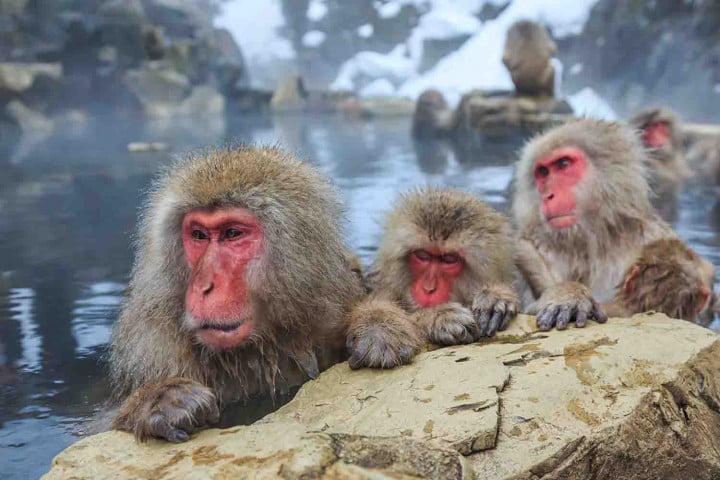
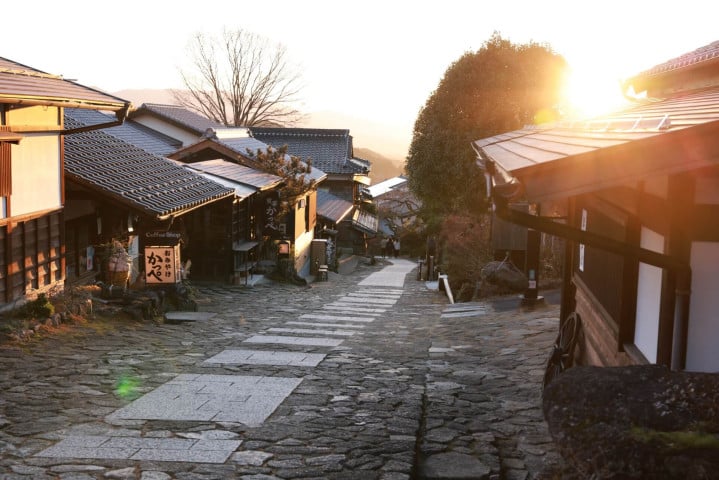
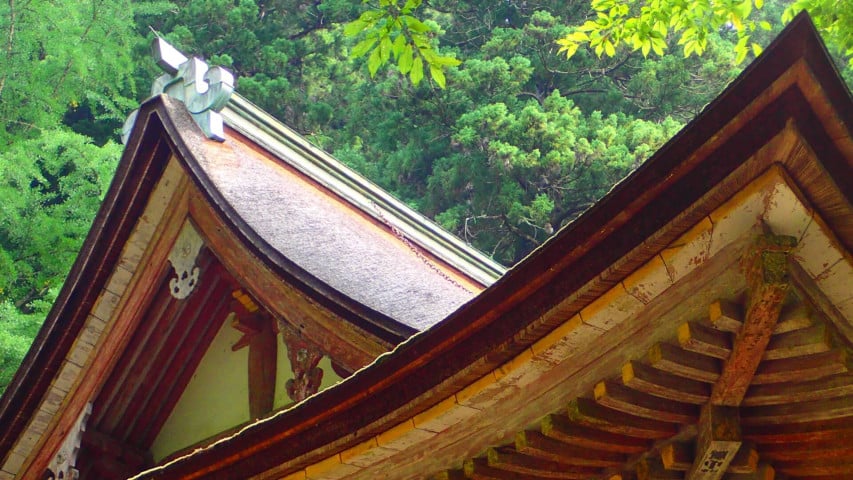
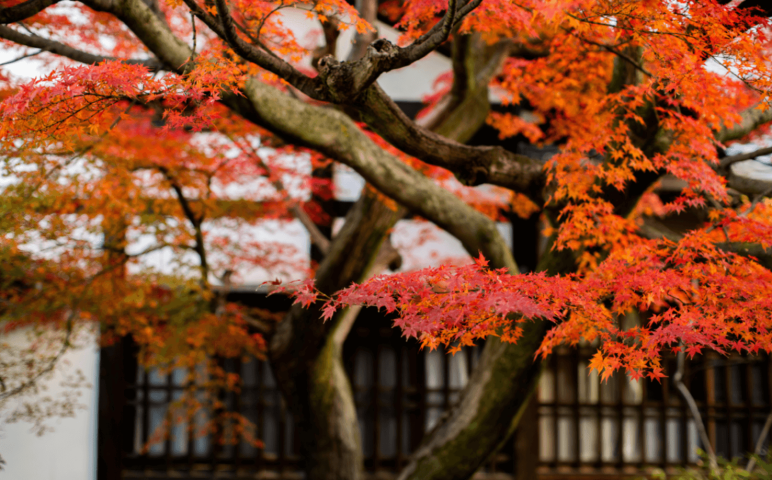
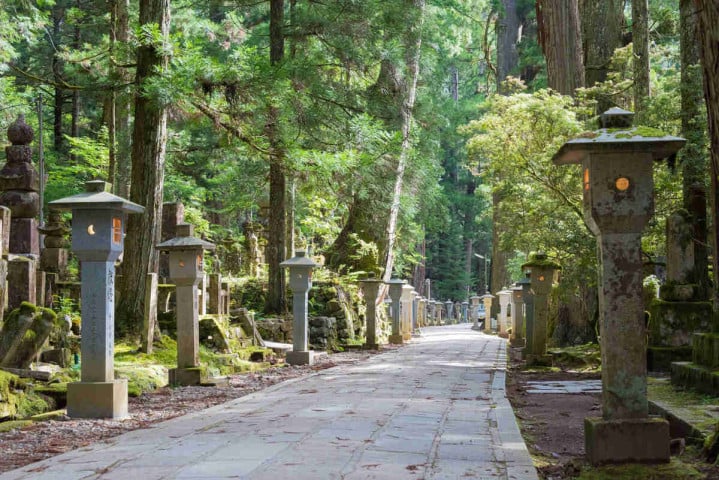




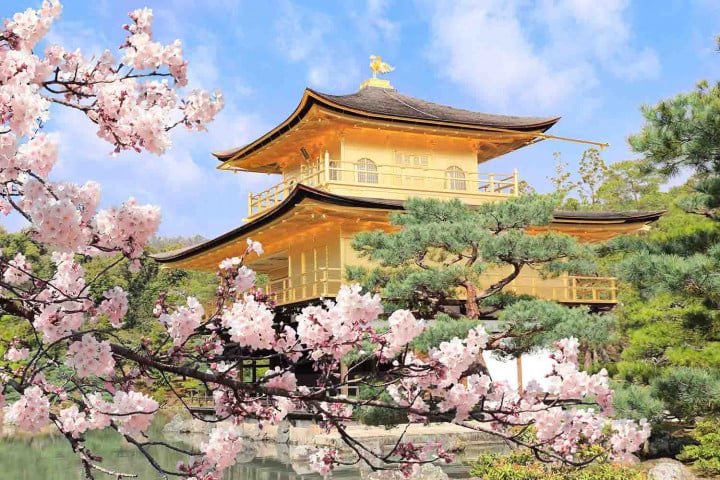
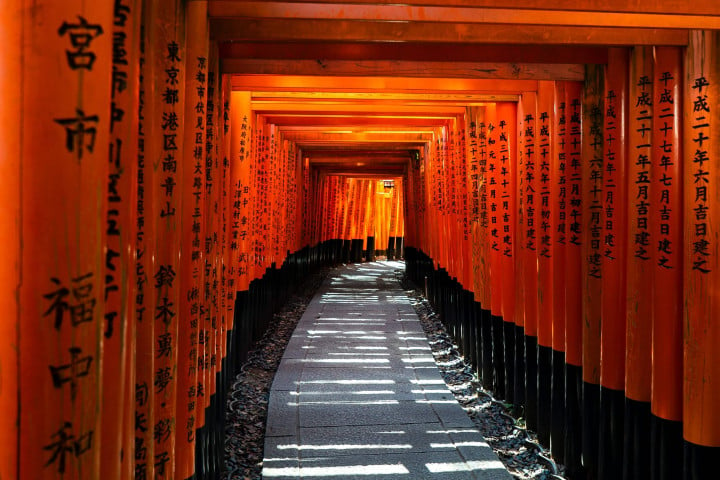
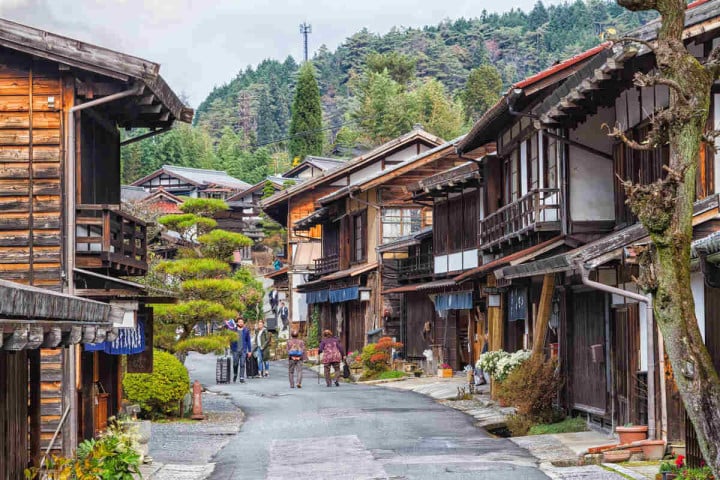
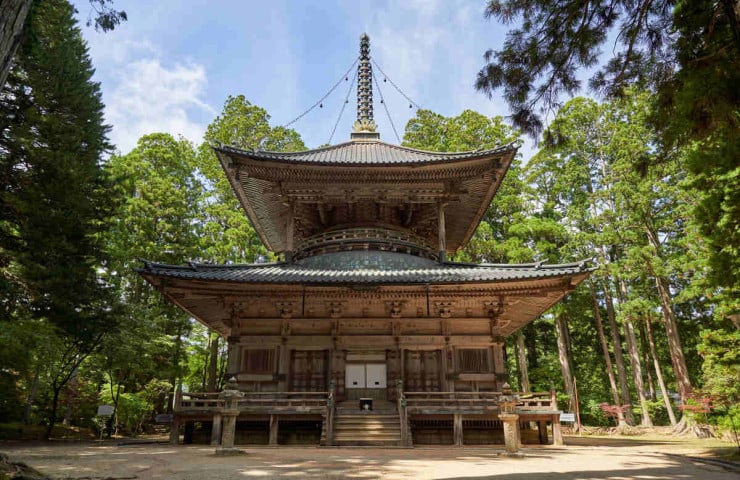
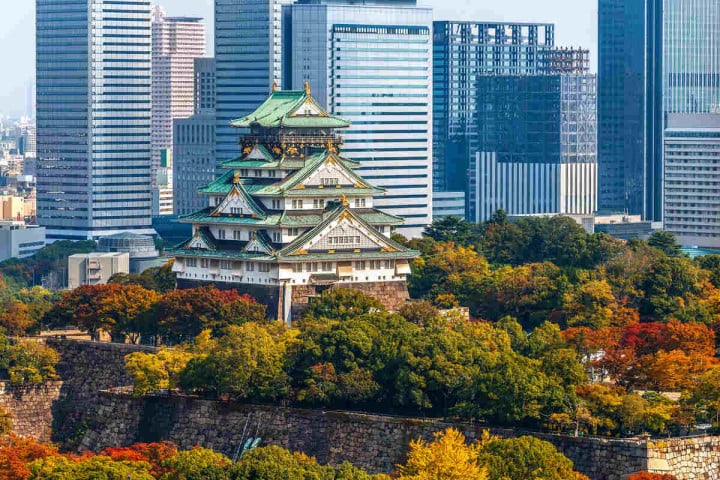



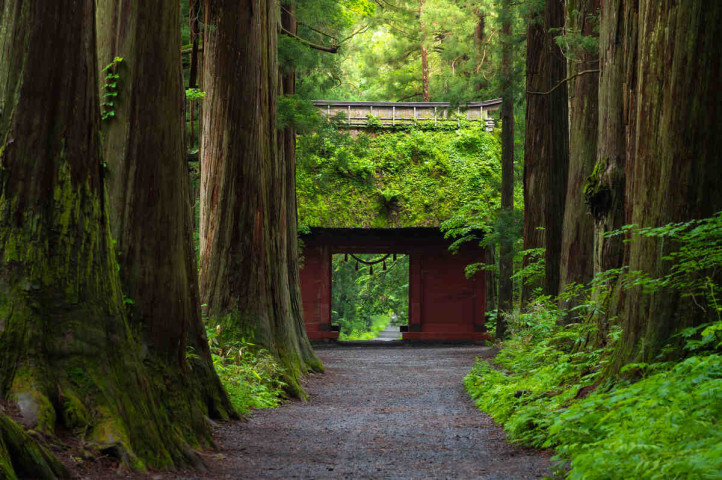
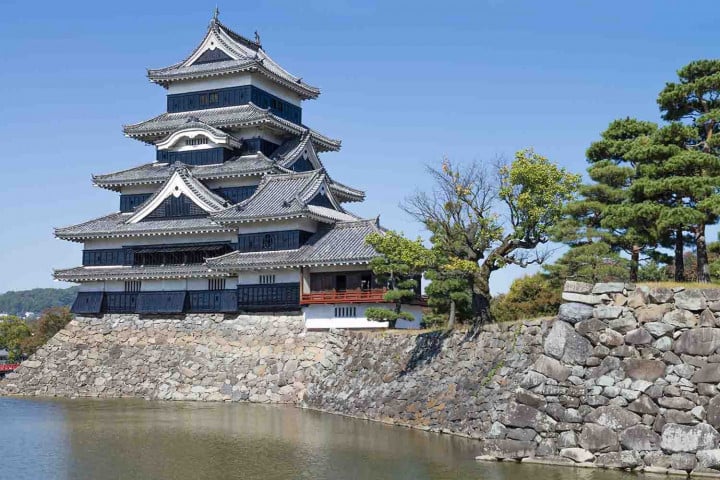








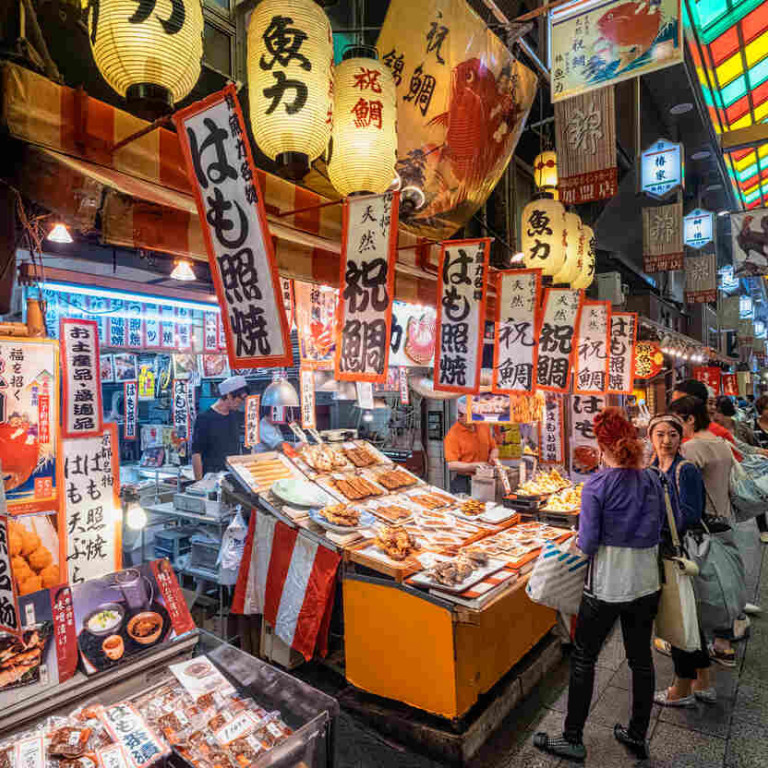
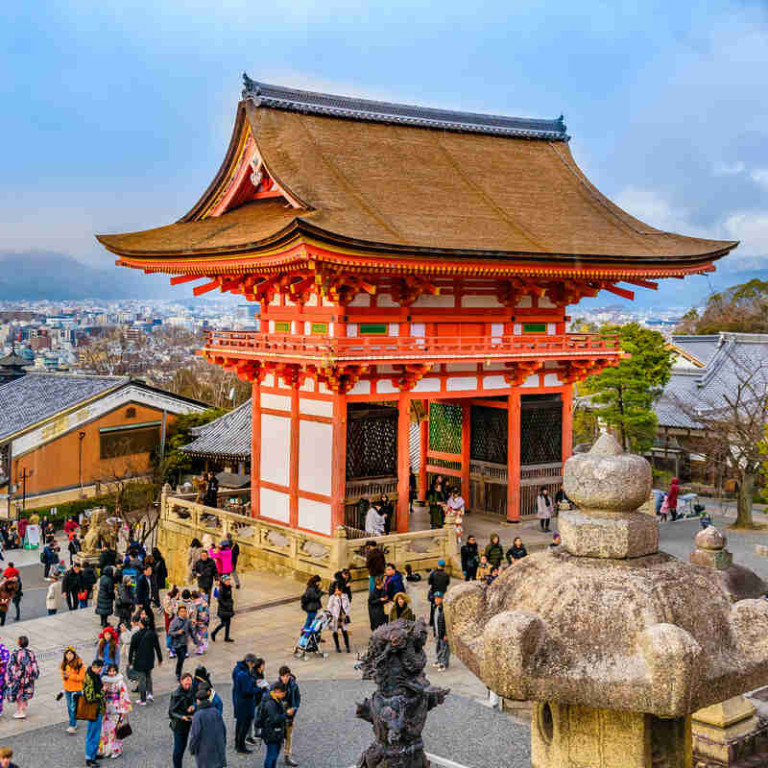










- Overview
- Itinerary
- Esential info
- Reviews
- Packing list
Intermediate
Activity
13 Nights
4 - 10
Group size
Leaders
Tour Highlights
- Thriving Tokyo, Kyoto, Osaka & Mt Takao
- Rural Azumino: wasabi farms, miso brewery & sake brewery
- Snow monkeys of Jigokudani
- Shibu Onsen & famous hot baths
- Forest shrines of Mount Togakushi
- Chuba Sangaku National Park
- Walk along the ancient Nakasendo Way & Kiso Valley
- Matsumoto & Nagano prefecture
Discover the history of Japan in this small group hiking tour
Visit a wide range of forests and national parks including; Mount Togakushi and Chuba Sangaku National Park.
A fascinating exploration of the Japanese Alps, the stunning mountainous area bisecting the main island of Honshu, this fully guided hiking tour is packed full of opportunities to experience the traditions and natural beauty of the area. Hike mountain forest trails with secluded shrines steeped in legend, walk along the Azusa River valley in the shadow of the Yakedake volcano, through the 'post towns' dotted along the ancient trade route in the Kiso Valley and explore Koya-san on the slopes of Mount Koya, a World Heritage town where over a 100 temples line the streets.
Experience onsen hot springs, visit a wasabi farm, make soba noodles and wonder at Matsumoto castle, with its 16th century wooden keep. Contrasting with the majestic Alpine countryside are visits to Tokyo, Kyoto and Osaka, famous respectively for their urban vibe, serene temples and delicious cuisine.
(Available as a small group hiking tour or tailor-made holiday)

At a gentle pace we walk (day hikes of 2-3hrs), and we embrace public transport to experience more of the culture and ambiance, using local trains, bullet trains, local buses and even a cable car! Our accommodation showcases the contrasts of Japan: from 3* western style urban hotels in the cities to traditional ryokan and simple temple accommodation where you will sleep on a futon mattress in a private room with tatami floors, sliding doors and shared bathrooms.
Experience Japan's exuberant cultural festivals
Japan's famous cultural festivals, known as matsuri, are colourful, lively events celebrated throughout the year, each with unique local traditions and historical significance. Festivals like Gion Matsuri in Kyoto showcase magnificent floats, while others like Tanabata celebrate folklore with stunning decorations. Some specifically honour deities or commemorate historical events, but they're renowned for spectacular and dynamic parades, traditional music, dancing, fireworks and an exuberantly festive atmosphere.
One of the more unusual is Kyoto's Kurama Fire Festival, which we include in our October 2024 walking tour.
If you'd like to attend one that's not listed here, speak to our team about creating a bespoke itinerary for you.
Please be aware that both our itineraries and Japanese festival dates can change.
Day 1: Arrival in Japan
Transfer
Welcome to Japan!
You will be transferred to the hotel by shared shuttle bus from Narita airport.
Today you can spend your day at leisure and rest before your adventure starts tomorrow!
Please note you may arrive today (the day before the tour starts) but this pre tour night is not included in the cost of the adventure.
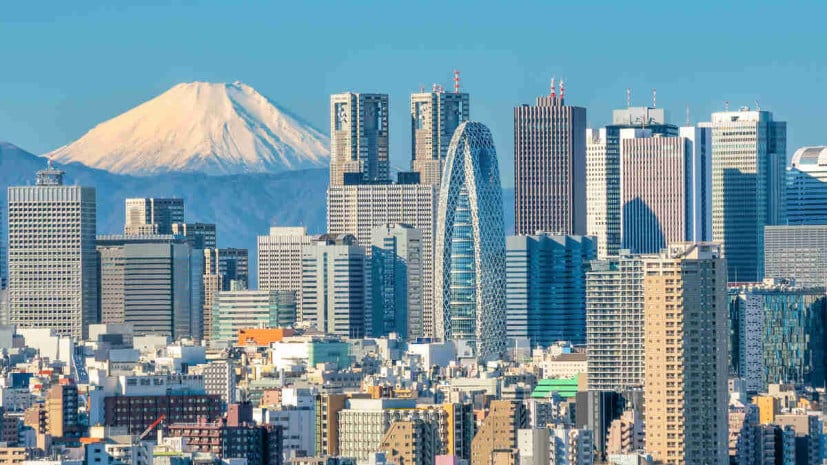
Day 2: Sightseeing in Tokyo
Transfer
Breakfast
Dinner
Boutique Hotel
Your journey begins in the thriving urban jungle of Japan's capital city, Tokyo. Situated on the main island of Honshu, Tokyo offers visitors a fabulous juxtaposition of the ultra-modern alongside enduring examples of traditional Japan—an inspiring and exciting introduction to the country.
As you’ll be arriving the day before the tour officially begins, you’ll have the unique opportunity to spend the entire day sightseeing with your guide. This allows you to dive straight into Tokyo’s dynamic atmosphere, taking in iconic landmarks, hidden gems, and local culture without the usual rush.
You'll also receive a Suica card preloaded with 1,500 JPY, usable on most local public transport nationwide, offering freedom to personalize your free time—perhaps even enjoying a night out.
This evening, depending on arrival times, the group will come together for a welcome briefing and dinner.
Stay at: SOTETSU GRAND FRESA TAKADANOBABA (or similar)
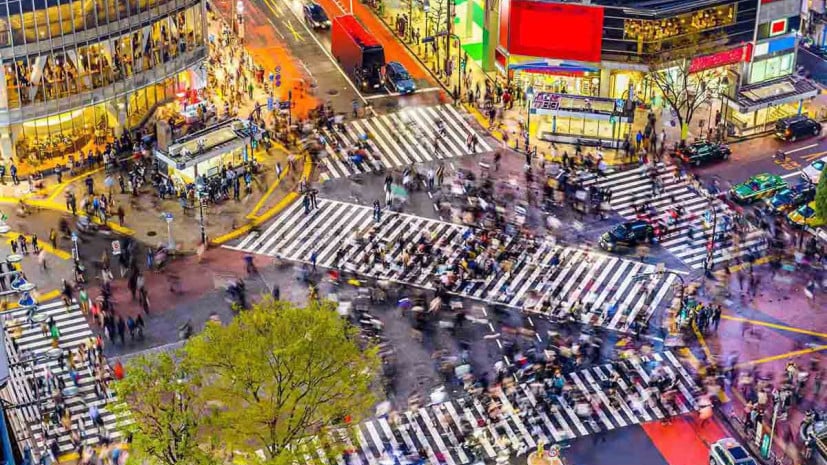
Day 3: Mount Takao
Train
Transfer
Breakfast
Boutique Hotel
Leaving the urbanised landscape of the Tokyo Metropolis behind this morning, we discover some tranquillity and fantastic views from the summit of Mount Takao (599m elevation), which, weather permitting, may include the peak of Mount Fuji.
Just a little more than an hour's journey by train, we will head out after breakfast to explore the variety of easy-to-follow hiking trails that have been developed in the forested slopes of Takao-san. From the base of the mountain, we have the option of taking the most used Trail 1 - the 3km Omotesando Trail. It is paved and takes in the essential sites but will probably be the busiest, so you may wish to take one of the many other varied options to suit your aspirations and depending on whether you want to head over a suspension bridge, waterfall, or through plum groves! All routes converge at the summit observation deck.
Near the summit look out for Temple Yakuoin where it is tradition to pray to the 'tengu' - a powerful mythical creature venerated in the Shinto & Buddhist religions - for good fortune. You may also like to have a look around the nature museum (free entry) to learn more about the ecology of the area.
Returning to the city in the late afternoon, with all the sensory input that brings, we have an evening of leisure to eat as a group or independently.
Stay at: SOTETSU GRAND FRESA TAKADANOBABA (or similar)

Day 4: Excursion to Nikko – UNESCO World Heritage and Natural Beauty
Train
Wildlife
Breakfast
Boutique Hotel
After a hearty buffet-style breakfast at your hotel in Tokyo, you’ll embark on a full-day excursion to the historic town of Nikko, one of Japan’s most culturally rich and naturally stunning destinations.
We’ll travel in comfort via reserved seat express train on the Spacia X or Kegon service from Asakusa to Tobu-Nikko, a scenic route that showcases the changing landscapes as we leave the city behind and head into the forested mountains of Tochigi Prefecture.
Upon arrival, you'll explore the highlights of the Nikko World Heritage Area, starting with a visit to the Toshogu Shrine, the lavishly decorated resting place of Tokugawa Ieyasu, founder of the Tokugawa Shogunate. This shrine complex, with its ornate carvings and rich history, offers a fascinating glimpse into Edo-period Japan.
Next, we head to the breathtaking Kegon Falls, one of Japan’s top three waterfalls, where you’ll enjoy entry to the observation area for spectacular close-up views. The journey continues with a photo stop at Lake Chuzenji, a serene mountain lake formed by volcanic activity, and a chance to view the iconic red-lacquered Shinkyo Bridge from the coach—an elegant symbol of Nikko.
In the afternoon, we’ll return to Tokyo via express train with reserved seating, giving you time to relax and reflect on the day’s discoveries.
This day offers a perfect blend of historical exploration and natural beauty, all made seamless and comfortable with reserved travel and expert guidance.
Stay at: SOTETSU GRAND FRESA TAKADANOBABA (or similar)
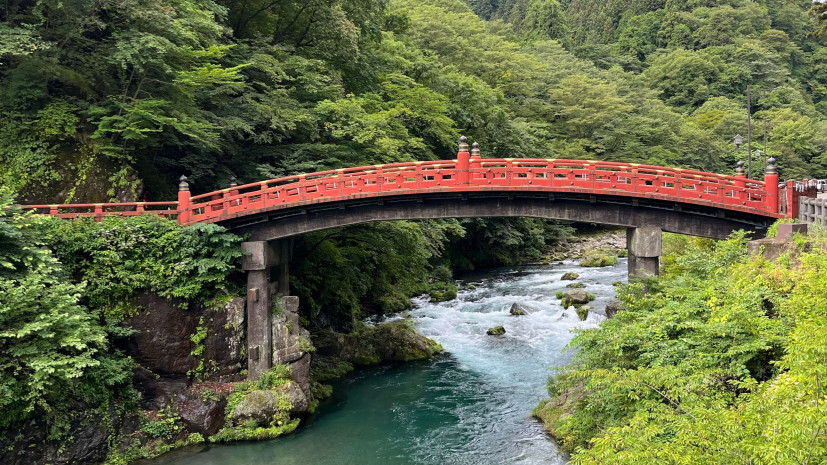
Day 5: From Tokyo to Nagano – Snow Monkeys & Hot Spring Charm
Train
Breakfast
Guest house
This morning, we say farewell to Tokyo and head to Japan’s mountainous heartland aboard the world-famous Shinkansen (bullet train). Traveling in 2nd class reserved seating, you'll enjoy a smooth and scenic ride on the route from Tokyo to Nagano, with travel times and train numbers confirmed closer to departure. The train is set to leave early to make the most of the daylight so we will provide a breakfast box or will add to your SUICA card so you are able to purchase breakfast.
Upon arrival in Nagano, you’ll have time to leave your luggage at the accommodation or in a station locker, ensuring you can explore the area freely and comfortably.
With your 2-day Snow Monkey Pass (provided by your guide), you’ll transfer to Yamanouchi via local train or bus, journeying into the beautiful mountainous region that’s home to one of Japan’s most unique wildlife experiences.
Your main destination is the Jigokudani Monkey Park, where you’ll witness the famous Japanese macaques (snow monkeys) soaking in natural hot springs—a truly iconic and unforgettable sight. The park is reached via a short, picturesque hike through serene forested trails.
After visiting the monkeys, enjoy time to explore Shibu Onsen, a charming traditional hot spring town nearby. You can wander its nostalgic streets, discover quaint temples and shrines, and maybe even try a foot bath or sample a local treat.
Later in the day, return to Nagano by local transport, where you'll settle in for the evening after an adventurous and memorable day in the mountains.
Stay at: Nagano Tokyu Rei (or similar)

Day 6: Exploring Togakushi and Zenkoji
Transfer
Breakfast
Guest house
After a continental breakfast at your hotel in Nagano, prepare for a day immersed in spiritual heritage, mountain landscapes, and tranquil forest paths.
You’ll begin with a scenic local bus transfer to Togakushi, a mystical area nestled in the Japanese Alps, known for its ancient shrines, towering cedar trees, and connection to Japanese mythology. Using your Zenkoji & Togakushi 1-Day Ticket, you'll enjoy easy and flexible travel throughout the day.
Your adventure starts at Togakushi Hokosha Shrine, where you'll disembark the bus and make a brief stop at the local information center to get oriented before setting out on the 5-Shrine Trail—a peaceful hiking route that links five of the area’s sacred sites.
The trail takes you through serene woodland paths and quiet mountain terrain as you visit:
Hinomikosha – Dedicated to the goddess of fertility and the arts.
Chusha – The central shrine of the complex, known for its tranquil setting.
Kuzuryusha – A small shrine enshrining the nine-headed dragon god.
Okusha – The inner sanctuary, approached through an awe-inspiring avenue of ancient cedar trees.
This trail offers not only spiritual insight but also breathtaking natural scenery, especially beautiful in spring, autumn, or under a gentle layer of snow.
In the afternoon, you’ll return to Nagano by local bus and visit one of Japan’s most important and historically significant Buddhist temples: Zenkoji Temple. While access will be to the free areas only, the temple grounds still offer a rich cultural experience, with its majestic wooden main hall and bustling street of shops and pilgrims.
After a full day of walking and discovery, return to your hotel in Nagano for a well-earned rest.
Stay at: Nagano Tokyu Rei (or similar)

Day 7: Azumino
Transfer
Breakfast
Boutique Hotel
This morning we head to rural Azumino by train (ticket included), with the fantastic opportunity to explore (including a boat tour) one of Japan's largest wasabi farms; Daio Wasabi Farm. Wasabi is a plant of the family Brassicaceae used to create a paste that frequently accompanies sushi and other Japanese dishes. Wasabi grows naturally along stream beds in mountain river valleys and Azumino has developed this cultivation to become one of the main production areas in the country. You may think you have tried it before, but outside of Japan, the high cost of wasabi means that the western horseradish is often used in its place - today you learn about how it is grown, but also get to taste the real thing for yourself.
Sticking with the theme of traditional dishes, we attend a local workshop to learn how to make soba (buckwheat noodles) with the help of an expert. We enjoy the end-result for lunch before moving on to visit a miso brewery. Miso, a Japanese staple, is a fermented soybean paste that has recently gained much popularity in the Western world as part of a dietary regime to encourage a healthy gut biome. The beans are fermented with salt and koi (fungus Aspergillus oryzae) and sometimes other ingredients are added such as rice, barley or seaweed. It is high in protein and rich in vitamins and minerals and is used for soups, sauces and spreads, as well as for pickling vegetables, fish & meats.
Last, but certainly not least, it would be remiss to not visit a 'nihonshu' brewery to learn more about the process used to make the infamous rice wine. In Japan, all alcoholic drinks are referred to as Sake. What we know as sake (fermented rice wine and soft water) is in fact, known as nihonshu. After a tasting, we take a coach ride to Matsumoto where we will stay the night.
Stay at: ONYADO NONO MATSUMOTO NATURAL HOTSPRING (or similar)
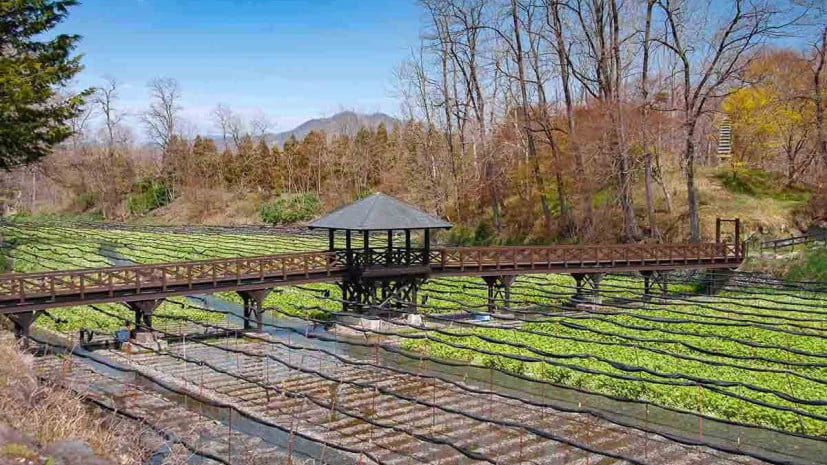
Day 8: Matsumoto & Kiso-Fukushima
Train
Breakfast
Dinner
Guest house
Wish your luggage 'sayonara' and, feeling the freedom, we head to the famous Matsumoto 'hirajiro' (a castle built on a plain rather than a hill or mountain), one of just 12 original Japanese castles that have remained intact. The black wooden keep, built in the late 16th century has earnt the castle the name of Crow Castle, and is in remarkably good condition; particularly its wooden interiors and external stonework. Don't miss out on seeing some of the steepest staircases in Japan and the openings that were used to drop stones onto invaders. The views from the observation deck on the 6th floor are worth the climb.
Depending on time, we may also visit the City Art Museum, with its collection of works by Yayoi Kusama, born in Matsumoto, before collecting our overnight bags from last night's hotel and taking the train to Kiso Fukushima, gateway to the beautiful Kiso Valley (and quite unrelated to the village in Fukushima prefecture that was so badly affected by a tsunami a decade ago). We explore the village on foot and spend the night in a ryokan where we get to relax in beautiful hot springs and enjoy a delicious dinner.
Stay at: KAIDO ROMANONYADO TSUTAYA (or similar)
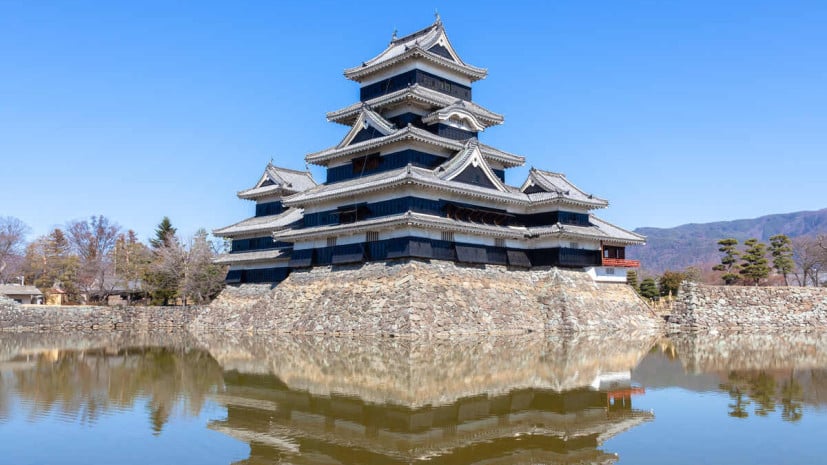
Day 9: Post towns of the Kiso Valley
Train
Transfer
Breakfast
Boutique Hotel
The Kiso valley runs alongside the mountains of the Central Japanese Alps. An ancient trade route, running 70kms along the valley, served as an essential means of commerce, particularly at the start of the Edo Period when it was joined to other local trade routes to form the 500km long Nakasendo ("path through the mountains"). This route offered an effective alternative for trade between Edo & Kyoto, to the coastal path (the Tokaido). Due to restrictions by the shogunate, in ancient times travellers were almost always forced to make their trips on foot, so every few kilometres 'post towns' popped up to provide accommodation and sustenance. A few towns in the valley, particularly Magome & Tsumago, have been preserved to look as they did when the served travellers, with stone paths and wooden buildings taking you back to a bygone era.
After a traditional Japanese breakfast we check out of our ryokan and journey to Nakatsugawa by train, then a local bus to Magome-juku for the start of a wonderful Nakasendo hike. The gentle walk, at a leisurely pace, takes us from the post town of Magome, to Tsumago. Here we pause and refresh before continuing for a little less than an hour to the nearby village of Nagiso. We jump on a train (included), to the city of Nagoya and transfer onto a Shinkansen (bullet train) for Kyoto where we are re-united, at our hotel, with our luggage.
You have free time for an explore and dinner.
Stay at: SHIZUTETSU PREZIO KYOTO KARASUMA OIKE (or similar)

Day 10: Kyoto
Transfer
Breakfast
Boutique Hotel
Japan's former capital (some might say 'better capital) is waiting to be explored this morning - and there is SO much to see!
The eastern side of the city is best walked at a leisurely pace from North to South to appreciate the numerous historic sites, but first we could do with some perspective, so we use public transport to arrive at the start of a short trail (1.5km, 220m ascent) to the top of one of Kyoto's most iconic mountains; Mt Daimonji. It gives us long panoramic views over Kyoto and is famous for the large Japanese character '大' meaning 'big', carved on the mountain side.
At the foot of the mountain lies the Ginkakuji ("Silver Pavillion"), one of the most exquisite zen temples in the city (entrance included), and a former retirement villa of a shogun before it was converted into a temple in 1492. As well as the main pavilion, there are half a dozen other temple buildings, a beautiful moss garden and a unique dry sand garden; the 'Sea of Silver Sand. From here we wander south along the Philosophers path, a tree lined canal-side pathway named after Nishida Kitaro, one of Japan's most famous philosophers who walked to Kyoto University by this route.
The pathway takes us past the Eikando and Nanzenji temples and we veer off here to visit Heian Jingu (entrance included). Heian is the former name of Kyoto, and this shrine, modelled after the ancient Imperial Palace and built just over a century ago, is dedicated to the spirits of the first and last emperors who reigned the city.
Nishiki Market offers us the perfect lunch opportunity before we walk through Gion the most famous 'hanamachi' (Geisha District) in the city. As we continue our walk south, we visit 'Yasaka', one of the most well known shrines in Kyoto, fronted by a dance stage where hundreds of lanterns, lit each evening and bearing the name of local businesses, hang in the breeze. Next up is the beautifully preserved historical district of Higashiyama, famous for its narrow lanes, wooden buildings and traditional merchant inns.
We end our tour at the stunning UNESCO World Heritage site of Kyomizudera, the temple of pure water, founded in 780, and one of the most celebrated Buddhist temples of Japan. The wooden stage that protrudes from the main hall and offers beautiful views of the city and surrounding hillside, was built entirely without the use of nails! We return to our hotel for a well earned relaxing evening at leisure.
Stay at: SHIZUTETSU PREZIO KYOTO KARASUMA OIKE (or similar)

Day 11: Kibune, Kurama, Kyoto
Train
Breakfast
Boutique Hotel
Today we experience one of the most beautiful hikes in the Kansai region. Using the cute Eizan train to Kibune-guchi station, we walk for 20mins or so to the village of Kibune, renowned for its traditional inns offering Kawadoko dining on top of the decks that span the narrow river.
We walk up a lantern-lined stone path to reach the Kibune shrine, erected in honour of the water goddess who travelled to the spot in a yellow boat (ki+bune). From here we start our hike (1hr) to Kurama-Dera temple, up an occasionally steep trail, through the majestic cedar forests. Here we find the main temple in Mount Kurama, dating back to 770, and known for its spirituality and breathtaking natural beauty. The temple's main hall offers a gorgeous view out over the surrounding mountains and is believed to be the birthplace of reiki.
Tengu, long-nosed or beaked creatures, thought to be guardians of the mountain, can be found as statues, arts and souvenirs in the village and temple complex. We visit the temple before walking down to the village where you can relax and enjoy some free time, with the option of bathing in a local onsen. After a tranquil day, immersed in nature, we take the train back to Kyoto (included) for an evening at leisure.
Stay at: SHIZUTETSU PREZIO KYOTO KARASUMA OIKE (or similar)
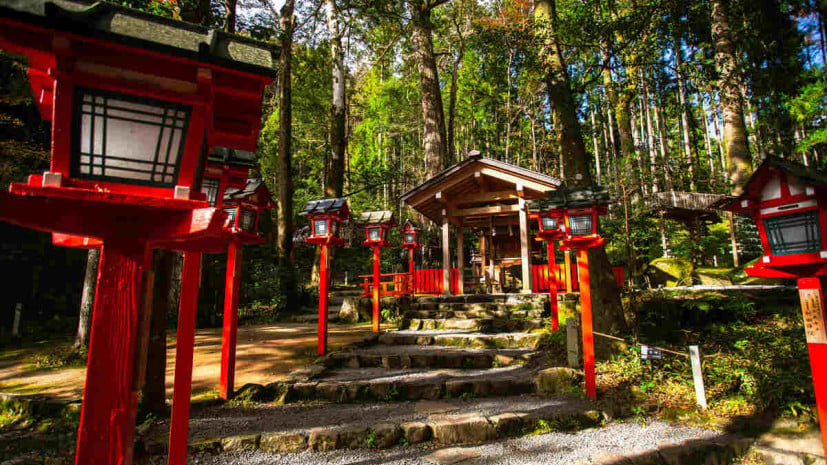
Day 12: Mount Koya
Train
Breakfast
Dinner
Boutique Hotel
Mount Koya is our destination today, a temple settlement (and UNESCO Heritage site) in Wakayama prefecture, south of Osaka.
We enjoy all manner of transport this morning: a train from Kyoto to Osaka, crossing the city to Namba station for another train bound for Gokurakubashi, and then a cable car climbing up the mountain! Finally we use a local bus for the last leg of our journey, into the heart of Koya-san.
In 805 Kobo Daishi, one of Japan's most significant religious figures introduced Shingon Buddhism to the area, Koya-san becoming the sect's religious centre. Over 100 temples have sprung up along the streets, transforming it into a secluded temple town. We visit Kongobuji temple, with its beautiful sliding doors and famous rock garden, and the atmospheric Okunoiun cemetery, the largest in Japan, with over 200,000 tombstones lining the 2km approach to Kobo Daishi's mausoleum.
This evening we stay at a Shukubo - a temple offering lodging which gives us some insight into the simple and traditional lifestyle led by Buddhist monks. We will have simple private Japanese rooms, with tatami floors, sliding doors and shared toilets. Futon mattresses are spread on the tatami floor for sleeping. Dinner will be served early with unique vegetarian cuisine called shojin-ryori. We will be given access to the temple, halls and garden as well as its communal, gender-separated baths.
Stay at: Henjoson Inn (or similar)

Day 13: Mount Koya to Osaka
Train
Breakfast
Dinner
Boutique Hotel
Guests staying at the temple are invited by the monks to participate in morning prayers (starting around 06:00), followed by breakfast at around 7.00.
We spend the morning in Koya-San, perhaps choosing to walk a part of the Choishi Michi, the old pilgrimage trails winding up the mountain. They are marked by stone signposts every few hundred metres. A variety of trails are available to suit your aspirations. Alternatively, you may wish to wander around the town, relaxing and absorbing the serene and spiritual atmosphere, before choosing somewhere for lunch.
Don't eat too much at lunchtime as this afternoon we will make our way back to Osaka for our last evening in Japan. Osaka is well known for being Japan's kitchen: a city for foodies! 'Kuidaore' is a quintessentially Osaka word meaning 'eat until you drop', and embodies the dedication of the local people to their food.
Time permitting we will visit the Dotombori area - known for its food markets. After a celebratory group meal, your leader will accompany you back to your hotel and say goodbye.
Stay at: THE B NAMBAKUROMON (or similar)
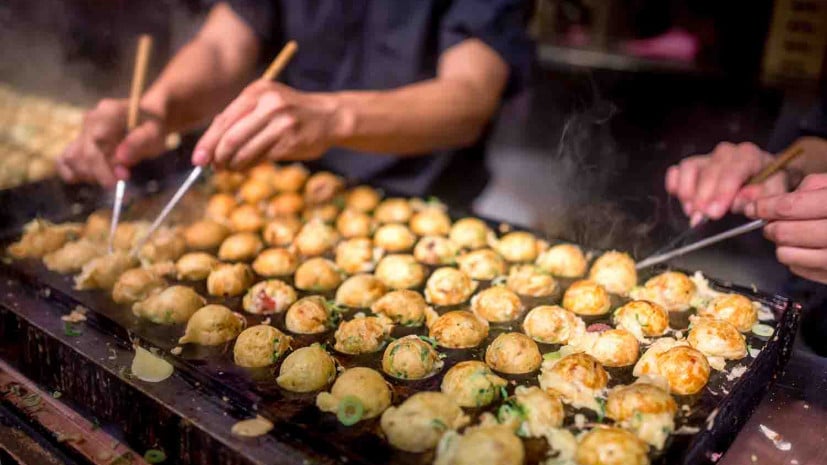
Day 14: Travel Home
Transfer
Breakfast
After breakfast you have some leisure time until your airport transfer by limousine bus (a scheduled service departing at fixed times from various stops around the city). Your guide will have explained to you how to reach the bus stop, or you can ask for help at your hotel reception.
Time to plan your next escape!

Adventure Optional Extras
Single Room Supplement
Single rooms are available on a first come, first served basis. We will charge on a pro-rata basis if a single room is only available for part of the trip.
Private Transfer - One Way Arrival from Haneda Airport (1 to 3 people)
If your flight schedules do not align with our group transfers (please refer to the essential info page for timings), you will need to arrange private transfers. Note that these transfers are one-way, so if you require them for both arrival and departure, please select two. After booking, you will be prompted to complete a travel information form where you can provide us with your exact flight times and details. This will enable us to organise your private transfers accordingly. Please note that private transfers may be subject to availability.
Private Transfer - One Way Arrival from Narita Airport (1 to 3 people)
If your flight schedules do not align with our group transfers (please refer to the essential info page for timings), you will need to arrange private transfers. Note that these transfers are one-way, so if you require them for both arrival and departure, please select two. After booking, you will be prompted to complete a travel information form where you can provide us with your exact flight times and details. This will enable us to organise your private transfers accordingly. Please note that private transfers may be subject to availability.
Private Transfer - One Way Departure from Kansai Airport (1 to 3 people)
If your flight schedules do not align with our group transfers (please refer to the essential info page for timings), you will need to arrange private transfers. Note that these transfers are one-way, so if you require them for both arrival and departure, please select two. After booking, you will be prompted to complete a travel information form where you can provide us with your exact flight times and details. This will enable us to organise your private transfers accordingly. Please note that private transfers may be subject to availability.
Pre Tour night in Tokyo for 2 people B&B
Stay in Tokyo the night before your adventure starts. Please note we will confirm hotel on enquiry, the rate provided is an estimate only.
Post Tour night in Osaka for 2 people B&B
Stay in Osaka the night before your adventure starts. Please note we will confirm hotel on enquiry, the rate provided is an estimate only.
Plant an additional 15 trees for your adventure
Carbon Compensation is not the perfect solution, and it is important to first reduce our carbon emissions as much as we can, yet trees remain an excellent natural technology to sequester carbon dioxide from the atmosphere to slow global warming.
For every client and guide who attends a YellowWood Adventure, we donate £30 to our partner charity WeForest to plant 15 trees to (over) compensate for the carbon footprint of the tour.
We also invite our clients to match this with an optional additional £30 for another 15 trees to be planted to help compensate for the carbon footprint of their international flights.
WeForest run many tree planting and tree maintenance projects such as this seedling nursery in the Amhara region of Ethiopia, the Amazon Rainforest in Brazil and many other projects in other countries including Zambia, Malawi, Tanzania & India.
Click Here to find out more about their amazing projects around the world.
Not Included
- International Flights & airport taxes
- Visas
- Insurance (compulsory)
- Public transport costs during independent 'leisure' time. You will use your pre-paid Suica card (JPY 1,500) for shorter journeys. Any top ups to the Suica card will be at your own expense. Your guide will help you with the top up.
- Some lunches & dinners - see itinerary for details
- Drinks & snacks
- Tipping (not widely expected - see Essential Info)
Contents
Accommodation
We fully believe in, and practice, Responsible Tourism and recognise the value of using hotels run by locals. The accommodation on this adventure really accentuates your experience and the mixture of hotels you will be staying in is very representative of the contrasts found in Japan. We feel that using different types of hotels helps deliver to you the complexity of Japan. It is a crazy patchwork of ancient & modern, corporate & family businesses, nature and urban, all of which coexist peacefully side by side. To authentically represent Japan, we have included as many of these as we can!
Having said that, there are themes with the various types of accommodation, and they will all be chosen for cleanliness, comfort, safety, proximity to our route (to avoid unnecessary extra travel which in Japan can be very expensive) and a warm client welcome, as well as reliability in their service to us.
Where hotels are fully booked or unavailable, we will use an alternative of a similar standard, and equally well situated. We will provide you with an accurate list of accommodation, with contact information to leave with relatives, prior to departure on your adventure.
Facilities
Unless you have booked a single room (where they are available) and paid the single room supplement for those nights, you will be sharing a twin room with another client (of the same gender).
Guiding & Your Group
Supporting you on your holiday will be an experienced, local, English speaking Japanese guide with a good knowledge of the areas visited.
We work closely with our Japanese Tour Operator partners both before and during your adventure to ensure that they understand your needs and the standard that YellowWood Adventures expects. We believe that it is a very important positive aspect of Responsible Tourism, to employ the expertise of local suppliers, as well as offering you a much more informative and authentic experience.
Your Group
Your group will be any number from our minimum group size of 4, up to a maximum of 12 clients. This number works really well with the ratio of guides, and ensures the optimum level of service to you during your adventure.
We get clients booking alone, as couples and in small groups of friends. If you have a group of friends or family who are interested in having their own customised trip, then please let us know and we can cost it for you.
Am I fit enough?
This adventure is a fabulous mix of sightseeing using public transport, and exploring on foot.
To get the most of out of this adventure, you need to be in good physical health, and enjoy walking as a way of exploring an area. You do not need to be an experienced hiker as the walks on the itinerary are taken at a leisurely pace (to enable wildlife spotting and photography) on well trodden paths, for short or intermediate periods of time (max of 3hrs) and with regular stops. You will be carrying just a day pack and bottle of water (bottled water) when walking or sightseeing.
Walking shoes or lightweight walking boots are more appropriate for this trip than hard and heavy walking boots.
Please note that you need to have an open mind to adventure travel, and experiencing different cultures to your own, first hand. You need to be happy using local buses and trains, as well as bullet trains (tickets included). We believe this gives you a far more immersive adventure, as well as a much better value one.
Travel & Arrival
Travel
Your YellowWood adventure starts at the airport in Tokyo. If you would like a private airport transfer then do add this on at the time of booking or get in touch, however there is a one-way shared shuttle bus from Narita airport to your start hotel included in the cost of your adventure.
Finding flights
Flights are not included in the cost of your holiday, and whilst we are happy to help advise you, responsibility for booking the correct flights rests with you. We recommend that you use a comparison tool such as www.momondo.co.uk or www.skyscanner.net when searching for flights.
It is worth noting, if you are going to be using domestic flights before or after your YellowWood adventure, that Japanese Airlines (JAL) and ANA offer discounted domestic fares to foreign visitors. These have to be e-booked directly via their websites.
On your plane into Japan you will be asked to complete landing cards (disembarkation cards) and a custom form to declare goods/cash you are bringing with you. These are then handed in at immigration / custom control. At the border control you will receive a passport stamp with landing date and allowed stay period.
Please ensure you check with your airline, the procedures you need to follow regarding checking luggage if you are transiting.
Foreign Travel Advice
For the latest travel advice from the Foreign Commonwealth & Development Office (FCDO) including security and local laws, plus passport and visa information, check www.gov.uk/foreign-travel-advice. We also receive notifications direct from the FCDO so we are always aware of the ‘status’ in our destination countries.
Arrival
Narita Airport: This is one of the international airports serving the Greater Tokyo Area of Japan, located 60km east of central Tokyo. Depending on whether you arrive via a domestic or international flight, you may or may not have to go through immigration. Following immigration, you will, as expected, head to baggage reclaim, then customs. You will be met with a signboard at the arrival exit by the shuttle service for the transfer to your hotel (we provide more information nearer the time).
Departure
Transfer to Kansai independently (transfer not included). Your guide and hotel reception can help advise you on how to reach the bus stop. Alternatively you can book a private transfer.
Insurance
Holiday insurance is essential for all Yellow Wood Adventures. Unfortunately, anyone without insurance is not able to take part in the holiday, so please make sure you arrange cover. We recommend arranging your insurance cover when you book so that if you have problems during the run up to your holiday, and need to cancel, you are covered.
YellowWood partners with battleface as a travel insurance provider. Click here for a quote.
battleface insurance is provided in the UK by battleface Insurance Services Limited, a UK insurance intermediary authorised and regulated by the Financial Conduct Authority. Details provided on this webpage are for information only. Terms, conditions, exclusions, and limitations apply. Always read the description of cover contained within your policy to ensure it is suitable for your needs.
Prior to the holiday, we will ask you to send us details of your insurer, policy number, 24 hour emergency assistance contact details and the name, address, and telephone numbers of your NOK or persons to be notified in the event of an emergency.
You must ensure the travel insurance you purchase provides you with suitable cover for the entirety of your trip. Your travel insurance must include cover in the event that you have to cancel for a reason outside your control prior to departure, for any medical expenses you may incur whilst away (including repatriation in the case of medical need) and for the activities which you may participate in during your trip.
General information on Japan
For information on Japan, such as climate, weather, language, social norms, food & drink etc, please have a read of our Country specificinformation.
Reviews
Helmut
***** Great guides! All the guides we had were enthusiastic, friendly and knowledgeable. Our mountain guide Mikki was exceptional. The walking involved some steep climbs, sometimes up uneven steps, but the views and the temples we visited were well worth the effort (we recommend you take walking sticks). The food was almost too beautiful to eat - but full of flavours when we did :0) The hotels were well positioned and universally good. Overall a fabulous trip if you want to see the Japanese countryside and not just the big cities.
Walking through the traditions & history of Japan 2025
Receive a 15% discount off Water-to-Go filtration water-bottles to help reduce plastic waste.
Compulsory
- US$ or GB£ to exchange for local currency
- Passport and Insurance Documents
- Credit / Debit Cards (for use in ATMs in cities only)
- Small first aid kit
- Washbag & usual contents
- Mosquito repellent
- Hand sanitiser (70% alcohol) & min of 2 reusable & 10 disposable face coverings
- Day rucksack for walking / sightseeing (approx 20L)
- Refillable water bottle
- Sunglasses & Sun cream (high factor)
- Plug adaptor
Clothing
- Socks & underwear
- PJs / nightwear
- Light tops that can be layered for day time - long and short sleeved tops
- Trousers, shorts & skirts as required
- Warm layer: fleece or jacket
- Waterproof jacket (good quality)
- Good hiking shoes with non slip soles or lightweight walking boots (worn in)
- Sandals or trainers
- Swimwear & quick drying towel for hot springs & Onsen
Optional
Optional
- Camera & charging cables / plug
- Ear plugs (if sharing, in case of snorers!)
- Umbrella
- Phone & Charging cables / plug
- Sun hat / baseball cap
Need a little help?
All adventures can be tailored as private bespoke trips.
Please contact us for more information:
+44 207 846 0197
Related Adventures
Booking Process
Select dates: Choose the dates for your adventure and consider adding any extra adventures or add-ons to enhance your experience.
Check the box to agree to our Terms & Conditions.
Make Booking: Click on "Make Booking." If you're booking more than 56 days before your adventure, you'll be redirected to secure WorldPay to make your deposit. If it's 56 days or less before your adventure, you'll need to make full payment. Rest assured, your money is held securely by the Association of Bonded Travel Organisers Trust.
Your booking will show as 'pending' in your YellowWood online account.
Confirmation: We'll be in touch as soon as possible to confirm your booking or discuss any availability limitations. Please refrain from booking transport or flights until we've emailed you to confirm your booking. (Note: Receipt of your booking form is not confirmation.)
Making payment: Once your booking is confirmed, we'll change the status of your final invoice from 'Pending Approval' to 'Outstanding,' indicating that it's ready for payment online.
You will receive a reminder email for your final payment 56 days before the departure date.
Feel free to contact us with any questions about your adventure or booking, we're here to help!

Grading
To help you choose the right adventure for you, we have given each itinerary a grading that relates to the level of Walking / Trekking you will experience during the trip. This grading can be found on the Yellow map on the adventure page of the website.
All of our trips involve a level of general activity so are designed for people who are in good health, enjoy the outdoors, and have a taste for adventure and some level of fitness. As will be clear from our destinations, the climate (and altitude) may be different to that which you are used to, so please take this into consideration when choosing the most suitable holiday.
Please read our Adventure Itinerary & Essential Information for more information and don't hesitate to contact us if you would like to chat through whether you have found a suitable adventure for you.
Grade 1-3: Entry Level
You need to be in good physical health to enjoy your active holiday, but you don’t need to be an experienced hiker. These itineraries offer a mix of sightseeing and easier walking for around 2-4hrs a day, with the emphasis on sights and cultural experiences.
Walks will be well marked or on defined pathways, and often around sites of interest. The expected amount of descent/ascent will depend on the landscapes of the destination, but will not exceed 400m/day, and will often be much less. Walks are at low altitude (below 3000m).
You will not be required to carry more than a day sack with water and essentials. Ensure you are aware of the weather conditions likely in the destination you are visiting and have a pair of comfortable and worn in walking shoes/boots.
Grades 4-6: Intermediate
You need to have a good level of fitness and be a regular walker for these adventures, with ideally some trekking experience. You can expect to be walking for 3-6 hours per day, not including rest stops, normally on good trail paths but with some uneven surfaces at times.
You will not be required to carry more than a day sack. You may be walking in more challenging temperatures. You will generally be walking at low altitude (below 3000m) but may walk at altitudes up to 4000m. The amount of ascent could be up to 800m in a day but will frequently be less. You may walk on consecutive days.
Ensure you are aware of the weather conditions likely in the destination you are visiting and have suitable clothing for this adventure.
Grades 7-9: Challenging
You need to have a good level of fitness with previous experience of trekking. Extra training before your trip will ensure that you get the most out of your adventure. Areas will be remote and terrain uneven.
Expect to walk for 5 – 8 hours a day, not including breaks, with some very steep ascents and descents. You will be walking at altitude (over 3000m but not higher than 5000m).
Ensure you are aware of the weather conditions likely in the destination you are visiting and have suitable equipment/clothing for this adventure (see the packing list for your adventure).
Please check individual itineraries for details of what you will need to be carrying with you.
Get in touch
CLICK HERE to schedule a call online with YellowWood Founder Sam McManus.
Or call us directly 24/7 on:



